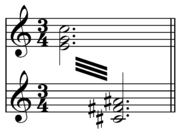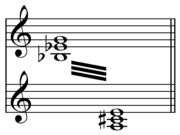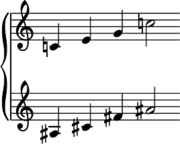
Petrushka chord
Encyclopedia

Polytonality
The musical use of more than one key simultaneously is polytonality . Bitonality is the use of only two different keys at the same time...
device used in Igor Stravinsky
Igor Stravinsky
Igor Fyodorovich Stravinsky ; 6 April 1971) was a Russian, later naturalized French, and then naturalized American composer, pianist, and conductor....
's ballet Petrushka and in later music. These two major triads
Major chord
In music theory, a major chord is a chord having a root, a major third, and a perfect fifth. When a chord has these three notes alone, it is called a major triad...
, C major
Major chord
In music theory, a major chord is a chord having a root, a major third, and a perfect fifth. When a chord has these three notes alone, it is called a major triad...
and F# major
Major chord
In music theory, a major chord is a chord having a root, a major third, and a perfect fifth. When a chord has these three notes alone, it is called a major triad...
- a tritone
Tritone
In classical music from Western culture, the tritone |tone]]) is traditionally defined as a musical interval composed of three whole tones. In a chromatic scale, each whole tone can be further divided into two semitones...
apart - clash, "horribly with each other," when sounded together and create a dissonant
Consonance and dissonance
In music, a consonance is a harmony, chord, or interval considered stable, as opposed to a dissonance , which is considered to be unstable...
chord
Chord (music)
A chord in music is any harmonic set of two–three or more notes that is heard as if sounding simultaneously. These need not actually be played together: arpeggios and broken chords may for many practical and theoretical purposes be understood as chords...
.
Structure

Tritone
In classical music from Western culture, the tritone |tone]]) is traditionally defined as a musical interval composed of three whole tones. In a chromatic scale, each whole tone can be further divided into two semitones...
(0 6). In Petrushka Stravinsky used C major on top of F major (the latter presented here in first inversion):

The device uses tones that, together, make up a synthetic hexatonic scale
Hexatonic scale
In music and music theory, a hexatonic scale is a scale with six pitches or notes per octave. Famous examples include the whole tone scale, C D E F G A C; the augmented scale, C D E G A B C; the Prometheus scale, C D E F A B C; and what some jazz theorists call the "blues scale", C E F F G B...
(0 1 4 6 7 t). When enharmonic
Enharmonic
In modern musical notation and tuning, an enharmonic equivalent is a note , interval , or key signature which is equivalent to some other note, interval, or key signature, but "spelled", or named, differently...
ally spelled C D E G G B, it is called the tritone scale. Alternatively, when spelled C D E F G B it can be read as the auxiliary diminished scale. It may also be categorized as a lydian♭7♭9 omit 13 scale.
The chords may be considered to contradict each other because of the tritone relationship: "Any tendency for a tonality
Tonality
Tonality is a system of music in which specific hierarchical pitch relationships are based on a key "center", or tonic. The term tonalité originated with Alexandre-Étienne Choron and was borrowed by François-Joseph Fétis in 1840...
to emerge may be avoided by introducing a note three whole tones distant from the key note of that tonality."
At the end of the third tableau the Petrushka chord appears with Petrushka but at A and E, which, with C and F, create a diminished seventh chord
Diminished seventh chord
A diminished seventh chord is a four note chord that comprises a diminished triad plus the interval of a diminished seventh above the root. Thus it is , or enharmonically , of any major scale; for example, C diminished-seventh would be , or enharmonically...
(0 3 6 9) and exhaust the octatonic scale
Octatonic scale
An octatonic scale is any eight-note musical scale. Among the most famous of these is a scale in which the notes ascend in alternating intervals of a whole step and a half step, creating a symmetric scale...
(9 1 4, 3 7 t, 0 4 7, and 6 t 1 = 0 1 3 4 6 7 9 t), "and suggests that it did...possess for Stravinsky an a priori conceptual status".
Petrushka and origin
Although attributed to (and popularized by) Stravinsky, the chord (or, more precisely, two simultaneous major chords set a tritone apart, specifically F and B major) was present much earlier in Franz LisztFranz Liszt
Franz Liszt ; ), was a 19th-century Hungarian composer, pianist, conductor, and teacher.Liszt became renowned in Europe during the nineteenth century for his virtuosic skill as a pianist. He was said by his contemporaries to have been the most technically advanced pianist of his age...
's Malédiction Concerto. (Although the exact date of the composition remains unknown, it is estimated by Humphrey Searle
Humphrey Searle
Humphrey Searle was a British composer.-Biography:He was born in Oxford where he was a classics scholar before studying — somewhat hesitantly — with John Ireland at the Royal College of Music in London, after which he went to Vienna on a six month scholarship to become a private pupil of Anton...
to be from circa
Circa
Circa , usually abbreviated c. or ca. , means "approximately" in the English language, usually referring to a date...
1840; the composition is believed to have originated from one of Liszt's early works, performed in 1827.) Maurice Ravel
Maurice Ravel
Joseph-Maurice Ravel was a French composer known especially for his melodies, orchestral and instrumental textures and effects...
uses this chord in his piano work Jeux D'eau
Jeux d'eau (music)
Jeux d’eau is a piece for solo piano by Maurice Ravel. The title is often translated as “Fountains”, “Water Games”, or “Playing water” . At the time of writing Jeux d'eau, Ravel was a student of Gabriel Fauré, to whom the piece is dedicated...
to create flourishing, water-like sounds that characterize the piece. In his article "Ravel's 'Russian' Period: Octatonicism in His Early Works, 1893-1908", Steven Baur notes that Jeux d'eau was composed in 1901, ten years before Stravinsky composed Petrushka (1911), suggesting that Stravinsky may have learned the trick from Ravel. Stravinsky heard Jeux d'eau and several other works by Ravel no later than 1907 at the "Evenings for Contemporary Music" program.
Stravinsky used the chord repeatedly throughout the ballet Petrushka to represent the puppet and devised the chord to represent the puppet's mocking of the crowd at the Shrovetide Fair. Eric Walter White suggests and dismisses the possibility that the Petrushka chord is derived from Messiaen's "second Modes of limited transposition
Modes of limited transposition
Modes of limited transposition are musical modes or scales that fulfill specific criteria relating to their symmetry and the repetition of their interval groups...
" (the octatonic scale) in favor of a "black key/white key bitonality" which results from, "Stravinsky's well known habit of composing at the piano."
Other uses
Jazz musicians utilize this chord as an upper structureUpper structure
In jazz music, the term upper structure or upper structure triad refers to a voicing approach developed by jazz pianists and arrangers defined by the sounding of a major or minor triad in the uppermost pitches of a more complex harmony....
to "colorize" a dominant chord. (see also Tritone substitution
Tritone substitution
In classical music, a substitute dominant is "a chord sufficiently akin to the dominant to be reasonably set against the tonic, and yet remote enough to give a chromatically expressive, large-scale dissonance to the structure"...
)

